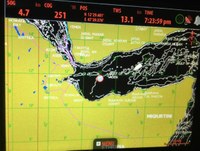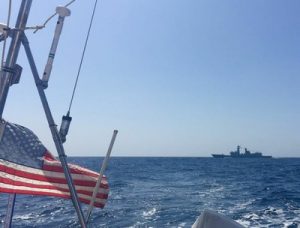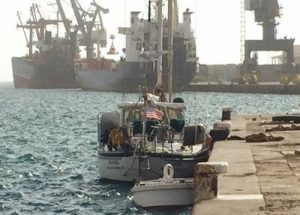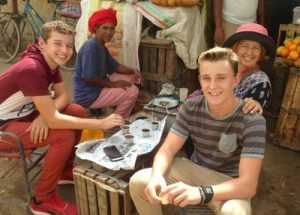Entry into the Red Sea via the Gulf of Aden – Our Story 2018
Checked in with UKMTO prior to departure.
Left Cochin March 10 2018, arrived Massawa, Eritrea March 30 2018.
Sailed, motor sailed, sailed, motor sailed, sailed. Motored 9 of the 20 days.
Published 7 years ago, updated 5 years ago


Followed winds to southern edge of eastern MSTC entrance, well above Socotra where coalition forces warned of increased piracy activity.
Stayed about 2nm south of the corridor. Glad we transmitted AIS and ran with lower running lights. Nearly hourly VHF ch16 broadcasts from coalition warships making their presence & services known. Daily, sometimes twice, naval aircraft flybys with direct radio contact made with each vessel.
Much communication between shipping traffic.
Twice we had what appears now to have been fishing boats approach us.
1) Mothership stopped 1.5 nm in front of us, boarded their 4 OB skiffs with men, and continued N as we did a 180 to see if they’d follow. No coalition warship responded but a US comms ship relayed. Asked if we saw ladders on board. Did not. Said likely a non-incident, which it was, but they monitored us for as long as we needed.


2) A 60′ dhow approached us from behind. When within 2nm, we hailed assistance without reply to coalition forces. UKMTO monitored us over email. Boat came within 200m, hailed MAYDAY. Djibouti port control responded, but were confused, thought we were at their harbour. A heard plane hailed naval aircraft on Ch.16 again. Successful. They flew over, monitored us, felt the boat proved a non-threat.
Sailed into Red Sea entering the west side of corridor and staying there until corridor ended, then sailed to Massawa, Eritrea.
So, nothing bad happened, just a couple of scares.
Eritrea
Predominately a Christian country Eritrea felt restricted, mostly because all Eritreans have become increasingly downtrodden by their government since 1996 when they gained Independence from Ethiopia after a 30-year war. The current leader runs the country as if they are still in a war, pretty much a dictatorship type government.


It was not unsafe, just not fun. Too many regulations, no credit cards, no ATM’s, no real Internet, not even email, no materials, limited supplies and expensive. We four were a major curiosity as everyone there is dark skinned with African/Egyptian features.
The country benefits very little from international trade nor industry aside from small clothing stores, some liquor stores, small limited grocery type stores and a central market where they sold flour (they are very proud of their delicious Italian type bread called “pan”), rice, coffee, fruits and vegetables (mostly onions, tomatoes, chili peppers, watermelons and bananas) and goats. Coffee shops are popular serving Italian coffees and tea, but few can afford to eat out. Some bars exist as Eritrean alcohol is sold cheaply. There are many, many beggars.
It was good to arrive to see the Friday night market. Solomon the taxi driver gave a great tour.


People are quite friendly – a lot of English is spoken along with Italian and Arabic – their official languages. We toured the nearby village close to the port of Massawa where we anchored (several bombed out “memorials” are still standing) and then took a 4-hour bus ride to the capital city, Asmara. The capital city is located on top of a mountain range so the temperature was cooler than we have lately experienced and rather cold at night. Aside from the official buildings and the churches, the capital city looked very worn with many closed businesses, no working stoplights, no active cinemas or malls. Don’t recommend spending money to see Asmara until the government improves.
Close to the ocean, it was terribly hot and humid. Very dusty everywhere – I was sneezing constantly. Our total stay was 6 days. No internet = no visa or master card payments. Everything is handled in cash. The people accept US$ but we exchanged our US$ into Nafka – their currency.
Clothing for women includes all styles: tight leggings/jeans and close fitting tops for the younger generations. Although not required, 75% of the women wear head and sarong type coverings and long dresses perhaps to keep off the dust. Men wear pants, some shorts, button-down shirts, T-shirts, and polos…all clothes were well worn. People squat on their feet when they get tired of standing…they rarely sit down at the ground or dirt is, well, dirty! Paved roads and tiled sidewalks (remnants of the Italian colonization up until 1941) are found in the capital and on main roads…the rest is hard packed dirt. Dust pervades everything covering your clothing and sweaty skin.


Eritrea was extremely expensive and slim pickings, so I bought just enough fresh provisions to get us by a large cabbage, tomatoes, okra, dozen eggs, potatoes, onions, oranges and a large watermelon. We’ve been eating through our dried and canned provisions in a big way since leaving Malaysia in February where I had stocked up. India didn’t have much in canned foods although we did find boxed liquid milk.
The once very active Massawa port is extremely sleepy. Eritreans are not allowed to leave the country. Before we lifted anchor, Immigration came aboard to check if we had any stowaways!
Up the Red Sea to Sudan (Suakin)
Our trip up the Red Sea took longer than expected. It was supposed to be 2.25 days and turned out to be 3 full days. The wind already coming from the north (we’re running late in the weather window) – thankfully with rather light winds. But with a 1.5 knot counter current, we did not progress quickly. Kandu is a slow-moving boat anyway.
See our Suakin report at the below link.
Leslie, Eric, Bryce and Trent
Related content
Related to following destinations: Cochin (Kochi), Eritrea, India, Massawa, Sudan
Related to the following Cruising Resources: Gulf of Aden / Indian Ocean / Red Sea, Piracy & Security, Red Sea, Routing





